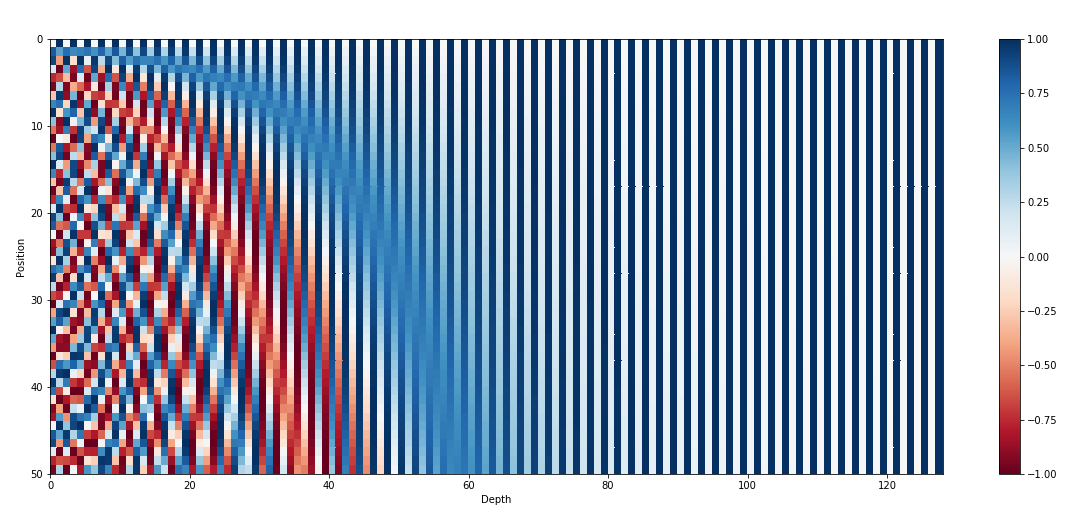
LLaMA中使用的Positional Embedding
前言
在第三次實驗室新生訓練時,講者用心介紹有關transformer training的過程,並且留了一個小作業,就是觀察LLaMA中positional encoding是使用了甚麼的技術,還有trace code的部分。而positional encoding也是在介紹transformer時,容易被忽略的一個細節。
Positional Encoding 簡介
由於transformer每次都是一整句話讀進去input,他不像RNN或VAE是透過時間序列,照順序傳入model,所以說幫transformer的input embedding做positional encoding是一件必要的事情。 舉個簡單的例子,
如果是VAE或RNN,就會一個字一個字傳進model,而transformer則是一次傳入一整句,而如果一次傳入一整句,transformer計算關係度時,就無法判別哪個
所以transformer需要Positional Encoding,而Positional
Encoding可以分成:
1. 絕對位置編碼:
最直覺的做法就是直接對input
embedding加上index,但這種做法有個壞處,當index很大時,可能會影響input
embedding的內容。
2. 相對位置編碼:
由於input
embedding是浮點數,透過相對位置編碼的做法可以改善絕對位置編碼花費多餘空間和normalize的問題。像是Self-Attention with Relative Position Representations這篇,他透過相對位置編碼來減少weight
matrix的運算。
3. 融合式:
這個做法的觀點是,乍看是用上絕對位置編碼,但是透過transformer的計算後,最後結果與相對位置有關。這類型的方法,多半仰賴於內積時對絕對位置相減(或是說指數相除)。例如:
(a) 三角函數型:
就是Attention is All You Need那篇的方法。
(b) RoPE(Rotary Position Embedding):
出於RoFormer: Enhanced Transformer with Rotary Position Embedding的方法。這方法的特色在於使用複變函數,而LLaMA就是用RoPE的做法。
三角函數型的方法與RoPE相比,缺點在於說他只能算出相對距離關係,不能確定說字之間的方向關係。
LLaMA使用的Positional Embedding
LLaMA使用的Positional
Embedding就是RoPE,我個人認為是融合了絕對位置編碼和相對位置編碼,硬要分的話就是絕對位置編碼。其方法很簡單,就下列的式子:

如果有修過通訊原理的話,應該很不陌生,兩個複數內積,其實就是將其中一個複數變成共厄複數後相乘再取實部,而複數與共厄複數相乘,在指數就是相減,RoPE透過將絕對位置編碼進歐拉數中,並透過transformer的計算,巧妙將output留下相對位置訊息。
RoPE Code分析
我們看到github: https://github.com/facebookresearch/llama/blob/main/llama/model.py#L56
1
2
3
4
5
6
7
8
9
10
11
12
13
14
15
16
17
18
19
20
21
22
23
24
25
26
27
28
29#......
def precompute_freqs_cis(dim: int, end: int, theta: float = 10000.0):
freqs = 1.0 / (theta ** (torch.arange(0, dim, 2)[: (dim // 2)].float() / dim))
t = torch.arange(end, device=freqs.device) # type: ignore
freqs = torch.outer(t, freqs).float() # type: ignore
freqs_cis = torch.polar(torch.ones_like(freqs), freqs) # complex64
return freqs_cis
def reshape_for_broadcast(freqs_cis: torch.Tensor, x: torch.Tensor):
ndim = x.ndim
assert 0 <= 1 < ndim
assert freqs_cis.shape == (x.shape[1], x.shape[-1])
shape = [d if i == 1 or i == ndim - 1 else 1 for i, d in enumerate(x.shape)]
return freqs_cis.view(*shape)
def apply_rotary_emb(
xq: torch.Tensor,
xk: torch.Tensor,
freqs_cis: torch.Tensor,
) -> Tuple[torch.Tensor, torch.Tensor]:
xq_ = torch.view_as_complex(xq.float().reshape(*xq.shape[:-1], -1, 2))
xk_ = torch.view_as_complex(xk.float().reshape(*xk.shape[:-1], -1, 2))
freqs_cis = reshape_for_broadcast(freqs_cis, xq_)
xq_out = torch.view_as_real(xq_ * freqs_cis).flatten(3)
xk_out = torch.view_as_real(xk_ * freqs_cis).flatten(3)
return xq_out.type_as(xq), xk_out.type_as(xk)
#......
上面就是RoPE中最重要的3個function。在funciton
precompute_freqs_cis中,就是提前計算絕對位置的歐拉數,也就是
function apply_rotary_emb就是計算前一小節RoPE理論中,分別計算
而在function apply_rotary_emb有用到function
reshape_for_broadcast,function
reshape_for_broadcast的用途就是將xq_,xk_和freqs_cis弄成相同形狀,才能進一步對矩陣逐元素相乘。
心得
這次的作業中,難得看到機器學習中用到訊號處理的方法。其實在之前,我一直覺得資工和通訊本來就很有關係,也覺得這類的數學很有趣。我也很推薦別人如果有閒暇時間,去修個dsp或影像處理,都是不錯的投資。
